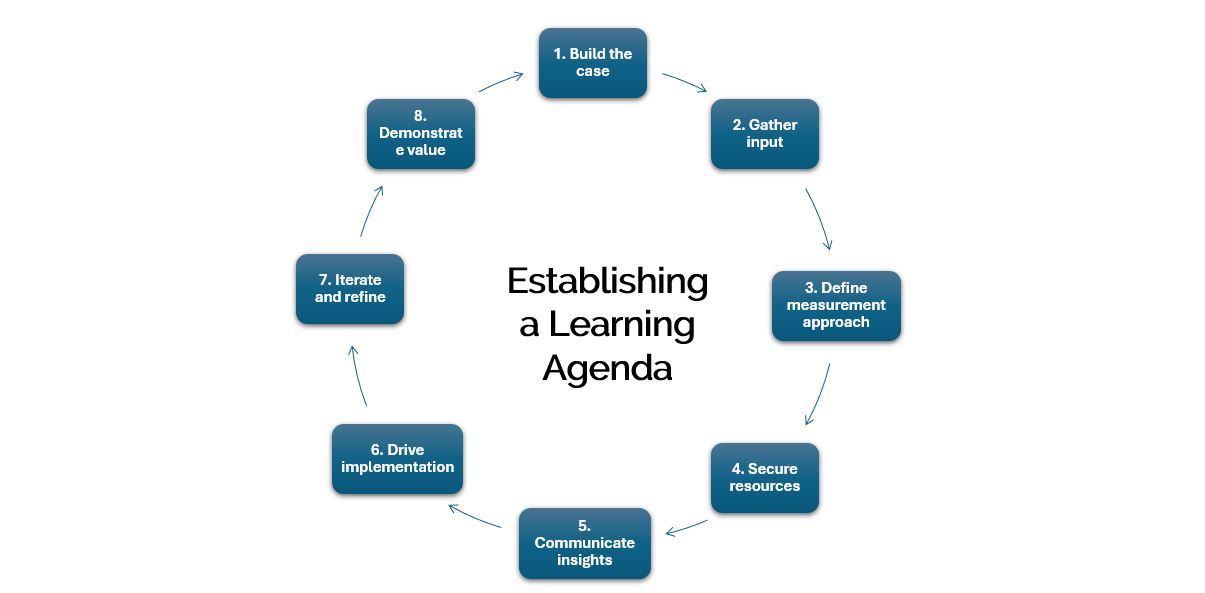Conflicting priorities and ad hoc requests often prevent businesses from adopting a strategic approach to learning about marketing effectiveness. With some essentials in place, marketers can overcome these hurdles and transform the value created for their organisation.
In today's environment of intense budget scrutiny, the concept of a structured Learning Agenda, as championed by the IPA's Making Effectiveness Work report, is more vital than ever. The report advocates a formalised agenda, driven by senior marketers, focused on insightful questions, and underpinned by a robust process. While this approach resonates in theory, practical hurdles like time constraints, budget limitations, and competing priorities often impede implementation. This article explores how to overcome these challenges and establish a Learning Agenda that truly delivers.
1. Leadership: The cornerstone of a successful Learning Agenda
A Learning Agenda's success hinges on strong leadership. This isn't simply about seniority, but about identifying a leader who can:
- Unify diverse perspectives: A Learning Agenda should address strategic and tactical questions from across the marketing team and beyond, incorporating input from finance, sales, CRM, insights, agencies, and other partners. The leader must synthesise these diverse needs into a coherent agenda.
- Champion evidence-based decision-making: They must be a recognised measurement expert, capable of fostering a culture that values data-driven insights and can guide teams in utilising various measurement techniques, such as Marketing Mix Modelling (MMM), experiments or attribution.
- Navigate organisational complexities: The leader needs strong internal connections and the ability to secure buy-in from key stakeholders, demonstrating the value of investing time and resources in a learning-focused approach.
Finding a dedicated and skilled leader is paramount. While the specific steps may vary in difficulty depending on the organisation's maturity, strong leadership remains the critical ingredient for success.
2. Key steps for establishing the Learning Agenda

Once leadership is in place, building strong internal connections is crucial. The following steps are key to getting the Learning Agenda off the ground:
- Build the case: Clearly articulate the business benefits of evidence-based learning to secure stakeholder support and resource allocation.
- Gather input: Conduct workshops and meetings across functions to identify key questions, hypotheses, and knowledge gaps. Establish a clear process for prioritising these questions.
- Define measurement approach: Collaborate with measurement partners and agencies to select appropriate methodologies for addressing the prioritised questions.
- Secure resources: Develop compelling business cases to secure budget approval for planned measurement initiatives.
- Communicate insights: Share results clearly and concisely, translating complex data into actionable recommendations.
- Drive implementation: Ensure recommendations are implemented and tracked, demonstrating the tangible impact of the Learning Agenda.
- Iterate and refine: Regularly review and adjust the learning plan based on stakeholder feedback and evolving business needs.
- Demonstrate value: Continuously track and quantify the business impact of decisions made based on insights derived from the Learning Agenda.
3. Staying focused: Avoiding business-as-usual distractions
Maintaining focus on the Learning Agenda requires active resistance against ad hoc measurement requests. The agenda owner must:
- Prioritise strategic questions: Ensure the agenda remains focused on long-term learning objectives, not reactive reporting.
- Maintain a regular cadence: Schedule regular reviews (e.g., quarterly) to track progress, reaffirm priorities, and adjust the agenda as needed.
- Differentiate between reporting and learning: Recognise that routine performance reporting, while necessary, is distinct from the deeper, hypothesis-driven investigations that fuel a Learning Agenda. Allocate dedicated time and resources for both.
Integrating learning into regular workflows, rather than treating it as a separate activity, helps ensure that insights consistently inform strategic decision-making.
4. The power of collaboration: Cross-industry learning
Cross-industry collaboration is essential for tackling complex marketing effectiveness questions. Issues like long-term brand building, evolving media roles, media's impact on price elasticity, and external influences are too multifaceted for single organisations to fully unravel. Pooling resources and knowledge offers significant advantages.
Collaborating with industry bodies like the IPA, agencies, and other advertisers unlocks opportunities like:
- Benchmarking: Accessing anonymised, aggregated data provides a broader market perspective, revealing performance improvement areas and best practices. Learning from others, even competitors, accelerates learning and fuels innovation.
- Knowledge gap closure: Collaborative initiatives pool resources to fund larger-scale research, exploring new methodologies, emerging platforms, and macro-economic impacts, addressing knowledge gaps individual companies can't tackle alone.
- Meta-Analysis contributions: Participating in meta-analyses like Thinkbox’s Profit Ability 2 provides access to robust, generalised insights and contributes to a collective understanding of long-term trends, informing evidence-based strategies.
- Standardised frameworks: Collaboration fosters the development of consistent measurement frameworks, improving comparability across organisations and facilitating shared learning.
- Innovation: Sharing challenges and solutions sparks new ideas and accelerates the development of cutting-edge measurement techniques, pushing industry boundaries.
By working together, sharing insights, and contributing to collective learning, marketers gain a deeper understanding of effectiveness, filling gaps within their knowledge.
In summary, a successful Learning Agenda requires strong leadership, a structured approach, and a commitment to continuous learning and cross-industry collaboration. By prioritising strategic questions, securing stakeholder buy-in, and demonstrating the value of insights-driven decision-making, marketers can transform measurement from a reactive cost centre into a proactive driver of growth. Embracing a learning culture empowers organisations to navigate the complexities of the modern marketing landscape and unlock the full potential of their marketing investments.
Olga Zaitseva is Head of Data Science & Modelling at EssenceMediacom
Explore IPA Effectiveness resources
The opinions expressed here are those of the authors and were submitted in accordance with the IPA terms and conditions regarding the uploading and contribution of content to the IPA newsletters, IPA website, or other IPA media, and should not be interpreted as representing the opinion of the IPA.



